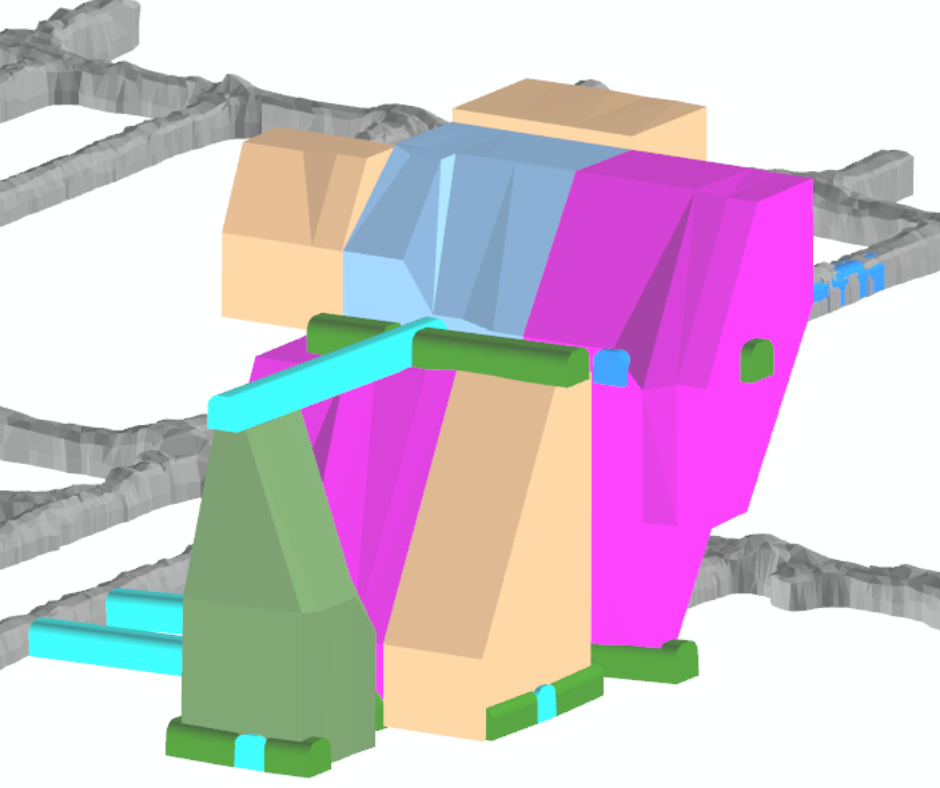The Importance of Stope Planning Prior to Drill Design
Practical and economic stope extraction is the result of quality planning. While this seems to be a diminishing or misunderstood practice, it is essential for a viable operation. While mine design can proceed without mine planning, it is the planning that adds the majority of the value. The key question to ask is: does this stope make money? There is no point in continuing to drill and extract a stope if it doesn’t make a positive impact financially.
Before time and money are spent on drilling and extraction, planning and production engineers need to consider the following key aspects of stope design.
1. STOPE GEOMETRY
- Mining Dimensions: Consider the orebody and drive dimensions to ascertain what can be practically and economically extracted. What is the minimum width you can practically extract with the equipment available? What is the maximum width possible considering the geotechnical constraints?
- Footwall Angle: Depending on the footwall angle, you may need to allow for a suitable angle to allow the ore to rill towards the draw point to ensure ore does not remain on a shallow footwall angle.
Each section should be designed with consideration of the previous section and also the overall stope geometry. Things to consider include:
- Can the stope be easily back filled?
- Can the stope be easily bogged?
- Will extra floor holes be required to obtain a smooth bogging horizon?
- Do draw points need to be designed to ensure maximum bog recovery?
- Should the profile of the stope backs be arched to increase stability?
- Do the physical parameters and constraints of the production drill rig allow drilling?
2. EXTRACTION
- Stope Location: Don’t look at just this stope; look at the surrounding area and identify anything that may impact the stope design or extraction. Are there any geotechnical structures that may impact the stope extraction? What other voids surround the planned stope?
- Rise Location: The initial opening is the most important part of a stope. Can you fire the rise successfully every time? If not, try to minimise designs that require the rise and slot rings to be fired together. Would a slot drive reduce the risk of poor rise/slot performance?
- Extraction Sequence: Optimise all the working areas required to extract a stoping area. Numerous ore sources in various stages of development, production and filling can all be extracted at any one time. Make sure there’s flexibility in the schedule to help reduce the impact of bridges and unplanned hold-ups, such as blockages in drawpoints. Sequencing is an extremely important aspect of any operation. It can lead to operations becoming profitable by allowing for ‘buffers’; prioritising critical path activities which in-turn will maximise utilisation of resources.
- Void Ratio: What is the minimum void ratio you require before taking the next firing? What is the swell factor of the ground?
- Blast Sequence: Would it be beneficial to charge the hangingwall with a low energy explosive? Have you checked the maximum instantaneous charge weights to reduce vibration?
- Bogging: Can all areas of the stope be bogged efficiently with either manual or remote bogging techniques? Make sure you consider design when you have a wide stope footprint that may have an uneven blasted floor, or 90 degree corners that are difficult to bog at the brow. Is there provision for blogger retrieval?
3. PARAMETERS
- Drilling Parameters: Consider drillhole diameter versus length of the holes required and expected deviation. Burden and spacing at different locations of the stope (slot versus rise, wall holes versus floor holes, collar location versus toe location) etc.
- Blasting Parameters: Keep in mind, which explosives you should use, (ANFO/Emulsion/etc) Which detonators you should use, (I-Kon/LPs/etc) What timing you should use between each ring and each hole in that ring.
4. STOPE OPTIMISATION
- Cut-Off Grade: Is this stope above the cut-off grade? Make sure you understand how the cut-off grade has been calculated. Understanding the costs of mining the stope, such as development, drilling, blasting, hauling, milling, etc. will assist in increasing potential profit.
- Stope Section Evaluation: After evaluating the entire stope, have you evaluated the economics of individual sections through the stope design? The overall grade might be above the cut-off grade, but can individual sections be optimised to increase profit?
- Low Grade Areas: Can low grade areas be optimised or should low grade pillars be designed?
- Practical Stope Design: Is the shape realistic? Can it actually be drilled, fired and bogged easily? What is the expected percentage of the stope to be extracted? Are you taking unnecessary dilution?
- Reconciliations: Use the data from previous stopes to optimise stope design and extraction sequences in order to improve performance and profit. Consider stand-off distances to known structures, use of low impact explosives on hangingwall/footwall contact, methods of reducing dilution, how to increase recoveries, and how to minimise dilution.
5. EQUIPMENT AND OPERATORS
- Equipment: Does the equipment on site have the capability of drilling the designed stope angles and height? How will the stope be developed and drilled out? Are squared profiles required for slot development to allow for tighter drilling angels or rises?
- Operators: It is important to understand and use the experience and capabilities of the operators, and not push them to drill anything beyond that. They will be able to tell you how the drilling is performing and may even be able to tell you if ore has been hit or not.
6. FINANCESSTOPE ECONOMICS
- Capture Costs: Use this in planning and optimising stopes by updating the cut-off grade periodically.
7. GEOLOGY
It is imperative that the engineer designing the stope communicates with the geologist during the stope design process to:
- Ensure the latest geology interp and block model is available in the relevant library for use
- Confirm the grade variables and confidence levels that should be used
- Review geology interp and block model with the geologist
- Review diamond drilling coverage and identify areas that need further definition
- Review any other relevant geological features (faults, dykes etc.)
- Clarify any issues that may arise during the stope design process
- Discuss geological expectations and possible opportunities within the stoping area
- Are there any anomalies in the block model which will affect the extraction such as high uranium levels requiring additional ventilation?
- If there are higher grade areas in the stope, the geology team may want these sections to be fired and bogged clean to manage material on the ROM. In some circumstances, blending ore improves milling recovery.
- Diamond Drilling: Review the diamond drilling information to ensure sufficient coverage of the planned area. Don’t rely only on the Geology Resource model or block model. Review the area and get confirmation by the geology department that they are confident with the current modelling.
- Grade Distribution: Liaise with the Geology department to determine if the grade distribution through the stope will assist in designing pillars if they’re required.
8. GEOTECHNICAL
- Ground Conditions: A sound knowledge of structures or voids will enable the use of different blasting techniques to reduce the risk of bridges. For example, you could use more primers around a known structure, anticipate hard brittle rock that fragments easier, or soft fractured rock which needs more energy as it dissipates through the ground.
- Stress: Plan to relieve or minimise stress at the early stages of an extraction. Examine the geotechnical inputs and how stress will impact stope designs and extraction. What are the level interactions (pillars) and stope limitations (strike length, maximum height and hydraulic radius)? Be aware that these change as the mine gets deeper and must be looked at before a level is drilled and extracted.
It is important that the engineer designing the stope communicates with the geotechnical engineer during the stope design process to:
- Discuss the site specific Ground Control Management Plan and clarify the recommended stoping spans, hydraulic radius limitations, and final design crown profiles
- Discuss the site specific geotechnical recommendations, including pillar locations, size and type (rib, crown, sill etc.) that may be required
- Consider predicted seismic response for mining induced seismicity and re-entry requirements
- Discuss Geotechnical Guidelines and any further recommendations from external geotechnical studies or reports
Thorough planning and timely knowledge of data is key for production engineers to consistently deliver a practical economic drill plan. Every underground operation has different ore geometries, different rock types and different drill and blast performance. It is very important to record and analyse stope performance so the findings can be used to improve future designs.
All the value added from previous planning (historical data, reconciliations, etc.) can be lost by inferior or rushed designs. Many people believe that the outputs from mine planning departments are mainly blasthole design and development layouts; however, mine planning and mine design are separate activities.
Remember: Prior Planning Prevents Piss Poor Performance & A Failure to Plan is Planning to fail. Reducing rushed plans paves the way for allowing for improved extraction and performance.


